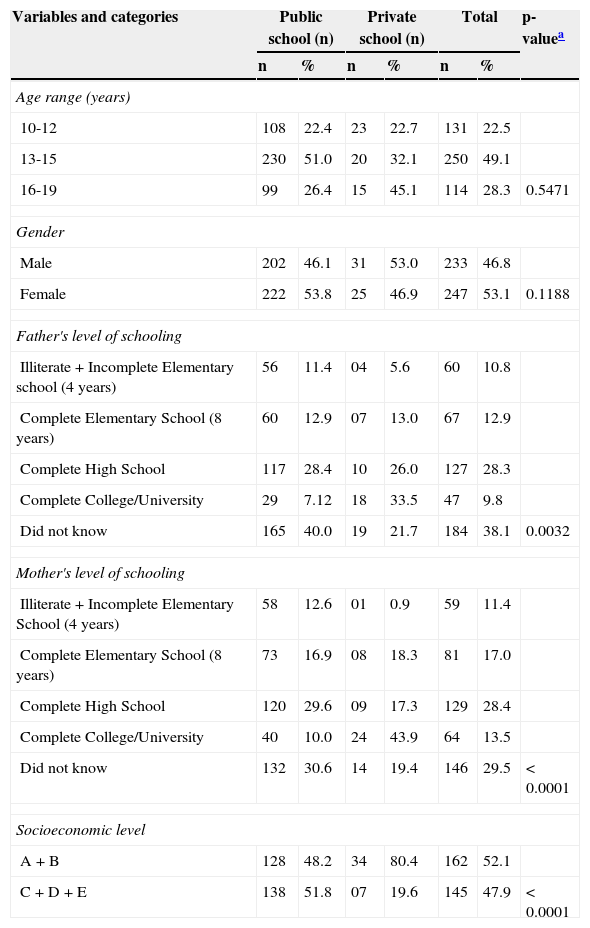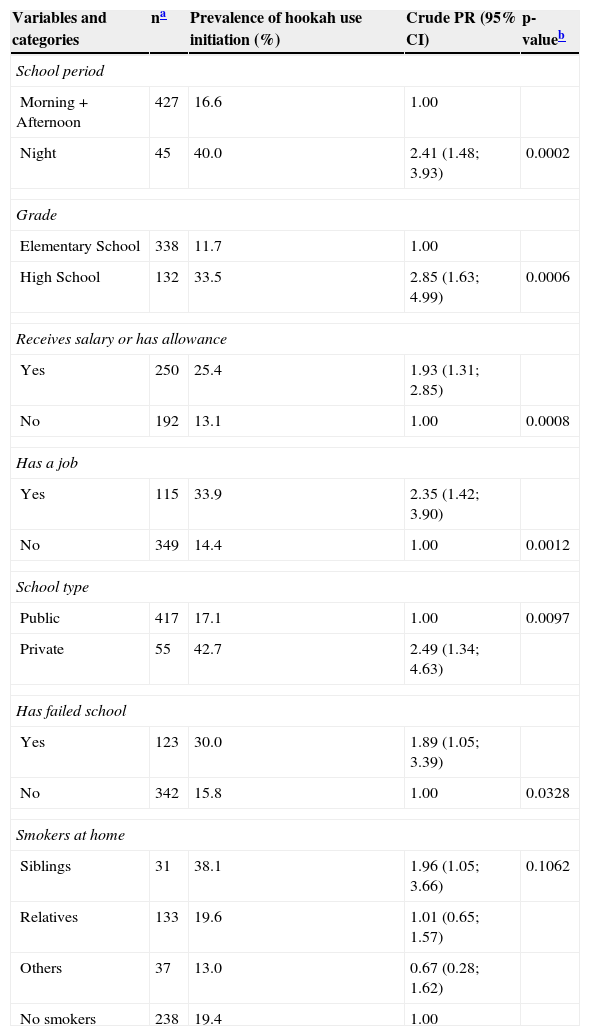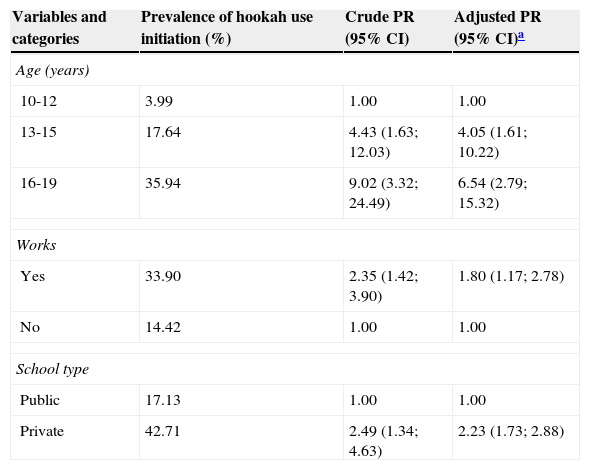to determine the prevalence and to analyze factors associated with hookah use initiation among adolescents.
MethodsThis was a cross-sectional study, in which questionnaires were collected from 495 students attending public and private schools of the urban area of the city of Várzea Grande, in the state of Mato Grosso, Brazil. Data were analyzed through descriptive, bivariate, and multiple Poisson regression analyses.
ResultsA total of 19.7% students had tried a hookah. The use of hookah was associated with the final period of adolescence [PR=6.54 (2.79, 15.32)]; enrollment in private schools [PR=2.23 (1.73, 2.88)]; and presence of work activities [PR=1.80 (1.17, 2.78)].
ConclusionThe proportion of adolescents that had tried a hookah was high. The influence of age, work activities, and class period on smoking initiation using the hookah was observed. Preventive measures encompassing all forms of tobacco smoking should be targeted at adolescents in the school environment, aiming at tobacco use control.
determinar a prevalência e analisar os fatores associados à iniciação do uso do narguilé entre adolescentes.
Métodostrata-se de um estudo epidemiológico transversal. Foram coletados 495 questionários dos estudantes das escolas da rede de ensino público e privado da área urbana do município de Várzea Grande/MT. Para análise dos dados foram realizadas análises descritiva, bivariada e regressão múltipla de Poisson.
Resultadosexperimentaram o narguilé 19,7% dos estudantes. O uso do narguilé está associado com o período final da adolescência [RP=6,54 (2,79; 15,32)], estarem matriculados nas escolas particulares [RP=2,23 (1,73; 2,88)] e exercerem atividades laborativas [RP=1,80 (1,17; 2,78)].
Conclusãoa proporção de adolescentes que experimentaram o narguilé foi elevada. Observou-se influência da idade do escolar, de atividades laborativas e do período das aulas para iniciação do tabagismo por esta forma. Medidas preventivas que abrangem as formas do tabaco devem ser direcionadas aos adolescentes, no ambiente escolar, como forma de controle do tabagismo.
Smoking is considered an important public health problem due to the high prevalence of smokers and to the morbidity and mortality of diseases related to tobacco use.1 Despite the decline in smoking prevalence, especially considering public policies implemented in recent years,2,3 many young people still experience different forms of tobacco use, becoming vulnerable to initiation, and consequently, to tobacco dependence.4,5 As smoking can also be considered a pediatric disease, teenagers are the main target for preventive and educational interventions aimed at interrupting the smoking initiation process. In this sense, the school is a privileged space for the study of this disease, as it identifies trends in smoking prevalence, producing data that help to understand this universe and, thus, to foster more effective preventive health policies for smoking control.4
Between 2002 and 2008, in the United States, cigarette use by adolescents decreased from 13.0% to 9.1%. In 2008, an estimated 1.4 million people aged 11 to 17 started smoking cigarettes.6 In Brazil, tobacco use among adolescents has reached alarming rates in several locations.7 In Cuiabá, state of Mato Grosso (MT), Brazil, the prevalence of smoking experimentation among the studied population was 30.2%; the most often associated factors were low maternal educational level, attending night school, having failed school, and having friends and siblings who smoke.8 There are no local studies describing the prevalence of experimentation of other forms of tobacco, such as hookahs.
The consumption of tobacco through a hookah is accompanied by a widespread belief in the population that this is less harmful than smoking cigarettes; moreover, smokers believe that this form of tobacco consumption is less addictive.9–12 As tobacco experimentation among young individuals remains a major impediment for the control of this endemic disease, and considering the harmful effects and addictive potential that the use of hookah promotes, this study was designed, aiming to establish the prevalence of hookah use and to analyze the factors associated with its use among adolescents in the city of Várzea Grande/MT, in order to support future public health interventions for prevention and control.
MethodsA cross-sectional epidemiological study was performed in public and private schools in 2011. The sample size was calculated by using the prevalence of tobacco experimentation among adolescents found in the study performed in Cuiabá, the capital of the state of MT, of 30.2%,8 with a sampling error of 0.05. The following result was considered in order to establish the predicted sample: minimum sample of 322×1.5 design effect=483+20% for losses=547.
Data from the Educacenso 2010, which were provided by the State Department of Education, were used for random sampling. Initially, a spreadsheet was created in Microsoft Office Excel 2003, and the sixth to ninth years of Elementary School and the first, second and third years of High School from public and private schools in the urban area were included. A total of 687 classes were listed in alphabetical and increasing order of education, with a mean of 19 students enrolled in each. Were included in this study 495 adolescents in the age group between 10 and 19 years who agreed to participate. A total of 21 questionnaires were excluded, as the date of birth was not provided.
Data collection was performed in school, at pre-established dates and times, scheduled with the school principals by the main investigator and a research assistant. Students were informed about the research in the classroom by the interviewers, who provided instructions for completing the questionnaire, which was answered by all students present in the classroom at the time of the visit and without the teacher's presence. An adapted, closed, self-report questionnaire,8 with no identification of the student was used for data collection.
Data were entered twice using an input mask, through Epi-Info 2000. Stata 1.0 was used for the statistical analysis. The chi-squared test was used to assess statistical differences between proportions and possible associations. In the univariate analysis, prevalence ratios and their corresponding 95% CIs were used as a measure of association between the dependent variable “use of hookah” and the other explanatory variables. To design the Poisson multiple regression model, all independent variables that had a p-value<0.20 in the univariate analysis were included in the model, considering as significant those with a p-value<0.05. The project was approved by the Research Ethics Committee of the University Hospital.
ResultsThe sample comprised a total of 495 students; 89.7% attended public schools and 10.3%, private schools. During the day, 86.2% of the students attended classes (Table 1).
Distribution of adolescents by type of school and socio-demographic variables, 2011.
| Variables and categories | Public school (n) | Private school (n) | Total | p-valuea | |||
|---|---|---|---|---|---|---|---|
| n | % | n | % | n | % | ||
| Age range (years) | |||||||
| 10-12 | 108 | 22.4 | 23 | 22.7 | 131 | 22.5 | |
| 13-15 | 230 | 51.0 | 20 | 32.1 | 250 | 49.1 | |
| 16-19 | 99 | 26.4 | 15 | 45.1 | 114 | 28.3 | 0.5471 |
| Gender | |||||||
| Male | 202 | 46.1 | 31 | 53.0 | 233 | 46.8 | |
| Female | 222 | 53.8 | 25 | 46.9 | 247 | 53.1 | 0.1188 |
| Father's level of schooling | |||||||
| Illiterate + Incomplete Elementary school (4 years) | 56 | 11.4 | 04 | 5.6 | 60 | 10.8 | |
| Complete Elementary School (8 years) | 60 | 12.9 | 07 | 13.0 | 67 | 12.9 | |
| Complete High School | 117 | 28.4 | 10 | 26.0 | 127 | 28.3 | |
| Complete College/University | 29 | 7.12 | 18 | 33.5 | 47 | 9.8 | |
| Did not know | 165 | 40.0 | 19 | 21.7 | 184 | 38.1 | 0.0032 |
| Mother's level of schooling | |||||||
| Illiterate + Incomplete Elementary School (4 years) | 58 | 12.6 | 01 | 0.9 | 59 | 11.4 | |
| Complete Elementary School (8 years) | 73 | 16.9 | 08 | 18.3 | 81 | 17.0 | |
| Complete High School | 120 | 29.6 | 09 | 17.3 | 129 | 28.4 | |
| Complete College/University | 40 | 10.0 | 24 | 43.9 | 64 | 13.5 | |
| Did not know | 132 | 30.6 | 14 | 19.4 | 146 | 29.5 | < 0.0001 |
| Socioeconomic level | |||||||
| A+B | 128 | 48.2 | 34 | 80.4 | 162 | 52.1 | |
| C+D+E | 138 | 51.8 | 07 | 19.6 | 145 | 47.9 | < 0.0001 |
Weighted percentages.
The prevalence of hookah experimentation was 19.7%; most students reported that they preferred to use it with friends (90.7%). There was no statistical difference between females (19.0%) and males (20.4%, p=0.7534). Among those who had experimented with a hookah, the proportion increased progressively and directly with age, with a prevalence of 3.9% in the age group 10-12 years, 17.6% in the age group 13-15 years, and 35.9% in the age group 16-19 years (p<0.0001) (Table 2).
Prevalence of hookah use initiation, prevalence ratio (PR), and confidence interval (95% CI) according to the classification of demographic variables, 2011.
| Variables and categories | na | Prevalence of hookah use initiation (%) | Crude PR (95% CI) | p-valueb |
|---|---|---|---|---|
| School period | ||||
| Morning+Afternoon | 427 | 16.6 | 1.00 | |
| Night | 45 | 40.0 | 2.41 (1.48; 3.93) | 0.0002 |
| Grade | ||||
| Elementary School | 338 | 11.7 | 1.00 | |
| High School | 132 | 33.5 | 2.85 (1.63; 4.99) | 0.0006 |
| Receives salary or has allowance | ||||
| Yes | 250 | 25.4 | 1.93 (1.31; 2.85) | |
| No | 192 | 13.1 | 1.00 | 0.0008 |
| Has a job | ||||
| Yes | 115 | 33.9 | 2.35 (1.42; 3.90) | |
| No | 349 | 14.4 | 1.00 | 0.0012 |
| School type | ||||
| Public | 417 | 17.1 | 1.00 | 0.0097 |
| Private | 55 | 42.7 | 2.49 (1.34; 4.63) | |
| Has failed school | ||||
| Yes | 123 | 30.0 | 1.89 (1.05; 3.39) | |
| No | 342 | 15.8 | 1.00 | 0.0328 |
| Smokers at home | ||||
| Siblings | 31 | 38.1 | 1.96 (1.05; 3.66) | 0.1062 |
| Relatives | 133 | 19.6 | 1.01 (0.65; 1.57) | |
| Others | 37 | 13.0 | 0.67 (0.28; 1.62) | |
| No smokers | 238 | 19.4 | 1.00 | |
CI, confidence interval; PR, prevalence ratio.
In the final analysis model, hookah experimentation was associated with the final years of adolescence [PR=6.54 (2.79, 15.32)], enrollment in private school [PR=2.23 (1.73, 2.88)], and presence of work activities [PR=1.80 (1.17, 2.78)]. This model was considered appropriate, with p=0.476 (Hosmer and Lemeshow's test) (Table 3).
Poisson's multiple regression model: variables associated with hookah use, 2011.
| Variables and categories | Prevalence of hookah use initiation (%) | Crude PR (95% CI) | Adjusted PR (95% CI)a |
|---|---|---|---|
| Age (years) | |||
| 10-12 | 3.99 | 1.00 | 1.00 |
| 13-15 | 17.64 | 4.43 (1.63; 12.03) | 4.05 (1.61; 10.22) |
| 16-19 | 35.94 | 9.02 (3.32; 24.49) | 6.54 (2.79; 15.32) |
| Works | |||
| Yes | 33.90 | 2.35 (1.42; 3.90) | 1.80 (1.17; 2.78) |
| No | 14.42 | 1.00 | 1.00 |
| School type | |||
| Public | 17.13 | 1.00 | 1.00 |
| Private | 42.71 | 2.49 (1.34; 4.63) | 2.23 (1.73; 2.88) |
CI, confidence interval.
The prevalence of hookah experimentation in this study is close to the values described in the cities of Campo Grande (18.3%) and São Paulo (22.1%), based on the secondary data side from Szklo AS et al (2011).13 The higher prevalence (29.6%) of the hookah use among students in Lebanon can be explained by the fact that hookah use is part of the Lebanese culture.14
Despite the lower prevalence when compared with the classical initiation of smoking, i.e., smoking cigarettes, the hookah experimentation rate is a matter of concern, indicating some degree of dissemination and popularization of this form of tobacco use. In addition to the glamour and the novelty of the process, it is also possible that a migration to other forms of tobacco is occurring, due to the success of policies restricting the use of industrialized cigarettes. It is known that the tobacco industry considers adolescents as potential consumers and, until recently, targeted advertisement towards sweet and menthol flavors, together with attractive packaging, for products used in hookahs.15 Despite this pressure from the industry, a decrease in cigarette smoking has been observed among students in state capitals of Brazil, which can be considered a positive result of anti-smoking campaigns.2,16
It is known that the use of hookahs allows socialization, mingling with friends, and relaxation moments, which can support the preference for hookah observed in this study regarding the place and the presence of company when using it. It can be observed that the frequency of use more than once a month is close to that observed among American students, who prefer weekly use (41%).17 Even if the student tries the hookah, he or she cannot yet be considered a smoker, but the harmful health effects that a hookah smoking session causes should be considered, as this form of tobacco consumption is as harmful as other forms of smoking, especially regarding the cardiovascular and respiratory effects.18–20 Additionally, hookah experimentation is a gateway to future nicotine dependence.
In the dependent variable association analyses, hookah experimentation and the other variables showed no differences regarding gender among those experimenting with hookahs, suggesting that the similar experimentation in both genders is related to the students’ interpretation of hookah effects on health. These results differ from studies that found a higher prevalence of males21 and others describing a greater number of females,14,22 with the latter authors explaining the higher prevalence is due to the country's culture, which represses the use of cigarette smoking by females. Regarding age, the prevalence of hookah use increased with the student's age, which was corroborated by other studies.17,22
Multiple analysis showed that the hookah experimentation was more prevalent in students from private schools, in disagreement with another study that described more experimentation among students from public schools.14 Regarding the socioeconomic class, the present results stands out, as a smaller proportion of smokers among individuals with a better level of schooling would be expected, considering that smoking is a disease associated with a population's low purchasing power.23 Possibly, the opposite occurred because the greater purchasing power facilitated the purchase of hookah equipment, becoming crucial to these findings. This fact is reinforced by another result found in the present study: a higher proportion of hookah use among adolescents who have their own income (workers), regardless of being from a low- or high-income family. These data are corroborated by the results of studies that found a higher prevalence of hookah use among adolescents who had jobs.21,22
Finally, tobacco experimentation and smoking initiation among adolescents is still a matter of concern, both in the traditional and alternative forms. Specially-created public policies should be directed at this population, with emphasis on educational campaigns warning that use of hookah is a form of smoking initiation that is equally or more harmful than smoking cigarettes. Thus, it can be concluded that among the adolescents studied, the use of hookah was associated with better socioeconomic class (private schools), increasing age (higher age range), and presence of work activities (better purchasing power).
Conflicts of interestThe authors declare no conflicts of interest.












